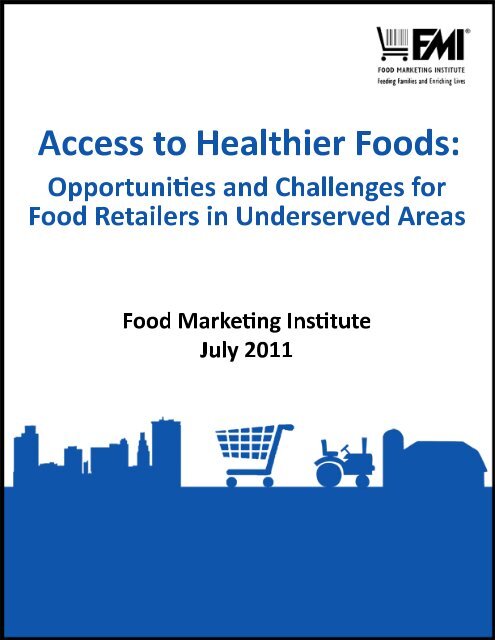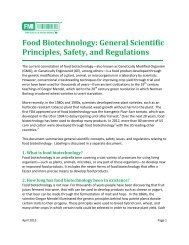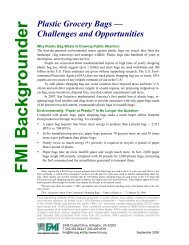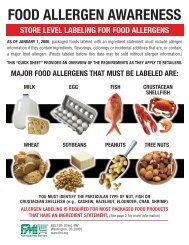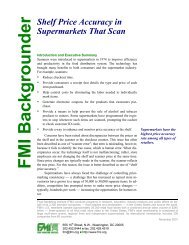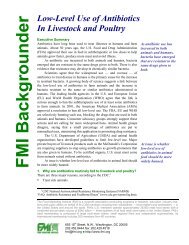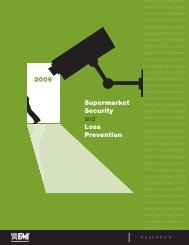Untitled - Food Marketing Institute
Untitled - Food Marketing Institute
Untitled - Food Marketing Institute
Create successful ePaper yourself
Turn your PDF publications into a flip-book with our unique Google optimized e-Paper software.
AccestoHealthier<strong>Food</strong>s:<br />
OpportuniesandChalengesfor<br />
<strong>Food</strong>RetailersinUnderservedAreas<br />
<strong>Food</strong>MarkengInstute<br />
July2011
Table of Contents<br />
Introduction .......................................................................................................................... 1<br />
Access to Healthier <strong>Food</strong>s: Defining the Problem .................................................................. 2<br />
The Grocery Industry: An Overview ....................................................................................... 4<br />
The Impact of Supermarkets on Low Access Areas ................................................................. 4<br />
Barriers to Grocery Store Development in Low Access Areas .................................................. 5<br />
Inadequate Demographic Base ............................................................................................... 5<br />
High Investment Costs ............................................................................................................. 6<br />
Higher Operating Costs ........................................................................................................... 6<br />
<strong>Food</strong> Assistance Program Policies ........................................................................................... 7<br />
Additional Barriers ................................................................................................................... 8<br />
Factors that Encourage Store Development in Low Access Areas ............................................ 9<br />
Economic Incentives and Grants .............................................................................................. 9<br />
Support of Local Government ................................................................................................ 10<br />
Utilization of Local Champions .............................................................................................. 10<br />
Communication of Success Stories and Innovative Ideas ...................................................... 10<br />
Nutrition Education of Customers ......................................................................................... 11<br />
Innovative Ways to Provide Healthier <strong>Food</strong> in Underserved Areas ....................................... 11<br />
Smaller Store Formats ........................................................................................................... 11<br />
Alternate Grocery Delivery Systems ...................................................................................... 11<br />
Enhanced Transportation Options ......................................................................................... 11<br />
Success Stories .................................................................................................................... 12<br />
Bibliography ........................................................................................................................ 13
Access to Healthier <strong>Food</strong>s: Opportunities and<br />
Challenges for <strong>Food</strong> Retailers in Underserved Areas<br />
Introduction<br />
Since the first supermarket opened its doors in 1930, the business of food retailing<br />
has remained consistent: sell a wide variety of foods at a reasonable cost. Over the<br />
years, food retailers have adjusted and adapted their formats, services and<br />
products to accommodate the needs of their customers. Like all businesses, food<br />
retailing is a for-profit enterprise, but unlike other businesses having larger profit<br />
margins, the typical grocery store’s profit after taxes is approximately 1.3% with<br />
the average store taking in approximately $6,000 per week in profit (based on<br />
median annual sales of $466,000). Although supermarkets provide an essential<br />
service to the communities they serve, they are businesses which must produce<br />
profit to stay viable. The lack of a supermarket in a community can have many<br />
consequences affecting the economy, health and social structure of the surrounding<br />
areas. However, encouraging supermarket development where it is needed is a<br />
multi-dimensional process requiring community support, financial investment and<br />
creative partnerships.<br />
2345 Crystal Drive ● Suite 800 ● Arlington, Virginia ● 22202<br />
http://www.fmi.org<br />
<strong>Food</strong> <strong>Marketing</strong> <strong>Institute</strong> (FMI) conducts programs in public affairs, food safety, research, education and industry<br />
relations on behalf of its 1,500 member companies — food retailers and wholesalers — in the United States and<br />
around the world. FMI’s U.S. members operate approximately 26,000 retail food stores and 14,000 pharmacies.<br />
Their combined annual sales volume of $680 billion represents three-quarters of all retail food store sales in the<br />
United States. FMI’s retail membership is composed of large multi-store chains, regional firms and independent<br />
supermarkets. Its international membership includes 200 companies from more than 50 countries. FMI’s associate<br />
members include the supplier partners of its retail and wholesale members.<br />
Access to Healthier <strong>Food</strong>s: Opportunities and Challenges for <strong>Food</strong> Retailers in Underserved Areas<br />
1<br />
July, 2011
Access to Healthier <strong>Food</strong>s: Defining the Problem<br />
There are more than 36,000 grocery stores across the United States. However, in<br />
some rural and urban areas of the country, convenient access to a local grocery<br />
store carrying a wide variety of fresh foods, such as milk, eggs, meat or poultry,<br />
bread, fruits and vegetables at a reasonable cost is not available. In some places,<br />
access to healthier foods may be available from other sources, including farmers<br />
markets, home delivery mechanisms, community gardens or other types of fresh<br />
food vendors. Since farmers markets are seasonal and sources of food other than<br />
grocery stores can be difficult and expensive to measure without conducting<br />
individual household surveys, indirect measures such as the presence or absence of<br />
full-sized grocery stores are typically used to assess access to healthier foods.<br />
Currently, the lack of access to healthier foods has been defined by the US<br />
Department of Agriculture (USDA) as the absence of a grocery store, which<br />
conducts more than $2 million dollars in annual sales and is within one mile of a<br />
census track in which more than 40% of the population has an income at or below<br />
200 percent of the federal poverty threshold (ERS 2009). According to this<br />
definition, approximately 4.1 percent of the U.S. population or 11.5 million people –<br />
located in both rural and urban settings - have low income and live more than one<br />
mile from a supermarket. Figure 1 shows the map developed by the USDA to show<br />
areas of the United States that have been designated as “food deserts.” Other<br />
organizations such as The Reinvestment Fund (TRF) have also estimated the lack of<br />
access to healthier foods using different methodologies and while their numbers<br />
and locations differ (see Figure 2), the problem remains the same: there are very<br />
few grocery stores in certain rural and urban areas of the United States.<br />
Factors such as the presence or absence of poverty, car ownership, distance from a<br />
grocery store, the fact that people may access food in a variety of ways in different<br />
locations, whether a grocery store is present or not, can all make it challenging to<br />
accurately measure food access. Both the USDA’s <strong>Food</strong> Desert Locator and TRF’s<br />
Low Access Areas map may serve as tools assisting grocery retailers, community<br />
developers and city planners in identifying potential areas for grocery retail<br />
development, but neither resource paints the whole picture. It should be noted<br />
that each area possesses unique needs and specific characteristics which must be<br />
taken into account when determining a course of action for providing access to<br />
healthier foods.<br />
Access to Healthier <strong>Food</strong>s: Opportunities and Challenges for <strong>Food</strong> Retailers in Underserved Areas<br />
2
Figure 1: USDA Map of <strong>Food</strong> Desert Locations in the United States.<br />
Figure 2: TRF’s Low Access Area Map of the United States<br />
Access to Healthier <strong>Food</strong>s: Opportunities and Challenges for <strong>Food</strong> Retailers in Underserved Areas<br />
3
The Grocery Industry: an Overview<br />
Solutions that will allow greater access to healthier foods must be considered within<br />
the context of the supermarket business environment. According to the U.S.<br />
Department of Agriculture, 52% of money for food is spent on foods purchased and<br />
eaten at home while 47% is spent on those eaten away from home. Data from<br />
Trends 2011 show that approximately 57% of grocery shoppers consider full service<br />
supermarkets as their primary store (FMI 2011). Another 29% report their primary<br />
store to be a supercenter (combines general merchandise with groceries such as a<br />
Super Target or Walmart Supercenter), while the remaining 14% report their<br />
primary stores to be discount stores (e.g., Target or Walmart), club stores (e.g.,<br />
Costco or BJ’s), limited assortment stores (e.g., Aldi or Save-a-Lot) and dollar<br />
stores. For two-thirds of shoppers, price is the primary motivator for selecting their<br />
primary store, particularly for people with low incomes. Most shoppers are less<br />
than five miles from their primary store and only 9% of those surveyed indicate<br />
that location drives their primary store choice.<br />
Grocery stores are often centers of economic activity within their communities.<br />
Many supermarkets are located near other businesses within retail developments<br />
with all entities benefiting from the cross traffic. In addition, some store formats<br />
include additional services such as an in store pharmacy and banking or dry<br />
cleaning services. Stand-alone supermarkets can also succeed but it is much more<br />
attractive for busy customers to be able to take care of several needs at once when<br />
grocery shopping. Full service supermarkets have remained the predominant retail<br />
format despite the growth of many different types of grocery retailers.<br />
The Impact of Supermarkets on Low Access Areas<br />
According to both the USDA <strong>Food</strong> Desert Locator map and The Reinvestment Fund<br />
<strong>Food</strong> Access data map, low access to supermarkets occurs in both urban and rural<br />
settings across the country. Although these settings are quite different, the<br />
reasons for limited access to supermarkets can be similar. For example, rural and<br />
urban areas often lack the customer base necessary to support a supermarket. In<br />
rural areas, low population density makes it difficult to capture market share. In<br />
urban areas, which are typically more densely populated, people living in the<br />
surrounding areas near a supermarket must be willing to shop there.<br />
Transportation issues can also be problematic for both rural and urban customers<br />
who do not own cars. While urban locations may have better public transportation<br />
Access to Healthier <strong>Food</strong>s: Opportunities and Challenges for <strong>Food</strong> Retailers in Underserved Areas<br />
4
or taxi cab options available, it can be highly inconvenient to transport large<br />
quantities of groceries by public transportation and expensive to do so by taxi.<br />
The absence of supermarkets in underserved areas is thought to affect the health,<br />
economy and social well-being of people living in that region. For example,<br />
observational studies have associated low access to healthier foods with higher<br />
obesity and disease rates. (It should be noted that two-thirds of Americans are<br />
overweight and most have high access to grocery stores). Both food insecurity and<br />
easy access to food have been linked with higher obesity rates, regardless of the<br />
food’s source (ERS 2009). There are few studies of food intake before and after<br />
grocery stores become available. The few studies that have been conducted show<br />
only a small increase in fruits and vegetables consumption. Consumption of<br />
healthier foods (e.g., fruits, vegetables, low-fat dairy or whole grains) will not<br />
reduce obesity without changes in other eating behaviors (e.g., consuming fewer<br />
calories) (ERS 2009). Clearly, there are no guarantees that simply providing access<br />
to healthier foods changes people’s eating habits; additional steps are required to<br />
change behaviors.<br />
There are economic costs to neighborhoods that lack grocery stores as well. <strong>Food</strong>s<br />
available through corner markets are usually more expensive, and travel costs in<br />
both time and money to distant grocery stores can be higher. Also, neighborhoods<br />
without grocery stores have fewer local job opportunities. The average<br />
supermarket hires 90 people or more directly from the areas where they operate.<br />
This can be a huge benefit in urban and rural areas with lower levels of economic<br />
development.<br />
Socially, supermarkets can directly impact their neighborhoods as well because<br />
economic development can reduce poverty and crime, attracting additional<br />
businesses to the area.<br />
Barriers to Grocery Store Development in Low Access Areas<br />
Inadequate Demographic Base<br />
Most grocery retail chains have well-defined store formats that they have developed<br />
to successfully serve a certain number of customers and achieve profitable sales<br />
volumes. Depending on competition from other types of grocery outlets in the<br />
area, attracting a sufficient customer base to successfully sustain a grocery store<br />
can be challenging. Typically, grocery chains look for areas capable of supporting<br />
their format rather than redeveloping their store concepts to fit a particular<br />
Access to Healthier <strong>Food</strong>s: Opportunities and Challenges for <strong>Food</strong> Retailers in Underserved Areas<br />
5
geographic or demographic area. For example, if a chain typically builds 48,000<br />
square foot supermarkets designed to serve 20,000 people, it makes little sense to<br />
offer that format in a county of 2,000 residents. Similarly, a store located in a low<br />
income urban area will have a greater chance of success if they are able to attract<br />
customers from surrounding neighborhoods possessing other economic<br />
demographics.<br />
High Investment Costs<br />
It is time consuming and expensive for grocery retailers to redesign their core store<br />
formats. To do so means higher investment costs and requires modification of<br />
business models, hiring practices and inventory requirements. While some chains<br />
do have flexibility in their store formats and approach, from a business standpoint,<br />
retailers need a fairly high confidence level that the store will succeed since most<br />
tend to avoid financial risk.<br />
There are many initial costs involved with building a new supermarket, including<br />
but not limited to the initial purchase of real estate, site preparation, construction,<br />
acquisition of permits for operating, equipment and shelving as well as workforce<br />
training needs. These costs are magnified and investments are jeopardized if there<br />
are delays in any of these areas. The typical supermarket takes between five and<br />
seven years before its initial investment costs ($8 to $25 million dollars) are<br />
recovered.<br />
Higher Operating Costs<br />
Insurance and Security Costs In high crime areas, insurance for damage and<br />
loss and providing extra security are necessary for store operation. Whether the<br />
security issues are real or perceived, the additional costs are necessary to address<br />
customers’ need to feel safe while shopping. Additional security may be supplied by<br />
the city or local government as part of an incentive package for store development.<br />
Some stores have community policing sub-stations near or in their shopping areas.<br />
However, other retailers find it necessary to hire their own additional security<br />
officers.<br />
Recruitment and Training Recruitment and retention of supermarket employees<br />
is an ongoing challenge for many grocery retailers. Grocery store employees<br />
require a variety of different abilities including being customer service savvy,<br />
having good communication skills, being capable of problem solving, possessing a<br />
strong work ethic and having an earnest capacity to learn on the job. Since most<br />
retailers hire directly from the surrounding neighborhoods, it is important that there<br />
be a reliable pool of potential employees. The time and cost associated with<br />
Access to Healthier <strong>Food</strong>s: Opportunities and Challenges for <strong>Food</strong> Retailers in Underserved Areas<br />
6
training employees dictates that the closer the community is to being “workforce<br />
ready,” the better. However, in communities with high chronic unemployment<br />
rates, workforce training needs can be extensive to overcome established patterns.<br />
<strong>Food</strong> Assistance Program Policies<br />
Timing of SNAP benefits <strong>Food</strong> assistance benefits via the Supplemental<br />
Nutrition Assistance Program (SNAP) can be a significant income stream for grocery<br />
stores serving populations of lower income customers. However, the timing of<br />
benefits issuance frequently creates cash flow, inventory and staffing difficulties for<br />
retailers. For example, in nearly all states (48 out of 50), benefits are released<br />
during the first two weeks of the month; only two states (Illinois and Missouri)<br />
release benefits throughout the maximum 20 allowable days in the month. Nine<br />
states release all SNAP benefits on a single day, and another nine release benefits<br />
over the course of two, three or five days. When benefits are released over the<br />
course of just a few days, stores have to be able to meet the high demands for<br />
inventory and staffing needs during that time. However, there may be very little<br />
business during the last few weeks of the month after benefits are spent, yet the<br />
store must continue to provide the additional inventory and staff.<br />
WIC Promotion Rules Some states allow retailers to develop materials to<br />
promote WIC-eligible foods such as produce, while other states allow stores to use<br />
only state-generated materials for WIC-eligible products. Shelf-talkers for WIC<br />
approved items are allowed by most but not all states, but if used must be applied<br />
to all WIC approved products in the store. In the produce section, this can mean<br />
that all items must have shelf-talkers which can create clutter and be difficult to<br />
keep in place. These approaches to policies and marketing rules complicate efforts<br />
to encourage WIC participants to take full advantage of their WIC benefits. For<br />
example, some WIC benefits have recently been expanded to include fresh fruits<br />
and vegetables. However, WIC recipients may avoid redemption of fresh items if<br />
they do not want to exceed their benefit allowance. Without educational efforts,<br />
WIC recipients cannot be sure how much they have spent if they are not<br />
comfortable calculating the unit cost times the weight of the produce.<br />
Access to Healthier <strong>Food</strong>s: Opportunities and Challenges for <strong>Food</strong> Retailers in Underserved Areas<br />
7
Figure 3: Shelf Labels for WIC-Approved Products in Minnesota<br />
The Minnesota Department of Health<br />
provides WIC-authorized food retailers<br />
with labels to display on the shelves to<br />
promote certain WIC-approved items.<br />
Figure 3 shows labels for fresh fruits and<br />
vegetables (Minnesota).<br />
WIC Licensing Moratoriums and Delays Stores operating in underserved areas<br />
must be able to redeem WIC and SNAP vouchers. California, Texas and Georgia,<br />
have declared moratoriums on new WIC licenses (as of June 2011). Only retailers<br />
that already have licenses can redeem WIC benefits when they open new stores.<br />
In other states, obtaining a WIC license can take months. For example, in New<br />
Jersey, wait times for new licenses have taken as long as 18 months. The<br />
economic recession may be responsible for some of the delays and moratoriums<br />
since many states are currently understaffed at the state level. Regardless, the lack<br />
of a WIC license may cause stores to turn away vouchers upon a WIC recipient’s<br />
first (and potentially only) store visit and can make it nearly impossible for new<br />
stores to successfully operate in predominantly low income areas.<br />
Additional Barriers<br />
Union Opposition Not all food retailers have unionized workforces which can<br />
cause tension with local unions. In some cases, local unions with strong ties to<br />
local government (city or county councils, etc) can block project development or<br />
impede approval and permit processes.<br />
Regulatory Permits States, counties, cities and local jurisdictions all have<br />
different processes and procedures required for the construction and operation of<br />
businesses. Each permit, license and approval can slow down a project.<br />
Exceptionally long delays can completely stall or force the collapse of a project.<br />
Too many hurdles can mean that a store will be forced to seek another location.<br />
Access to Healthier <strong>Food</strong>s: Opportunities and Challenges for <strong>Food</strong> Retailers in Underserved Areas<br />
8
Transportation infrastructure While different, both urban and rural locations<br />
face transportation challenges. In urban areas, transporting goods in congested<br />
areas is more expensive and time-consuming. Trucks and delivery vehicles must<br />
maneuver in tight spaces and heavy traffic and cope with the challenges of<br />
inadequate unloading situations. Customers in urban settings require adequate<br />
parking, and streets and sidewalks that are in good repair. In rural areas, grocery<br />
stores located further from distribution centers encounter greater transportation<br />
costs for inventory, particularly when fuel prices skyrocket. Effective access via<br />
highways and roadways and enhanced energy-efficiency incentives will be<br />
important to keep trucking costs manageable for the rural food retailer.<br />
Factors that Encourage Store Development in Low Access Areas<br />
Economic Incentives and Grants<br />
A major hindrance to opening stores in low access areas is acquiring the financial<br />
resources to initiate and support the project through the first five to seven years (or<br />
longer) that it may take before the store recoups start-up costs. Financing needs<br />
can be met or offset through:<br />
• Community Development Corporations (CDCs) In many lower income<br />
areas, CDCs strive to improve economic development, enhance training<br />
opportunities for residents, and can generally provide insights into a<br />
community’s needs and challenges. They can be instrumental in working<br />
through local politics. As non-profit organizations, they can access financing<br />
that is not available to for-profit businesses.<br />
• Financial Incentives, Tax Credits and Grants In some areas, financial<br />
initiatives have been developed to encourage businesses to operate in low<br />
income areas. Through these initiatives - offered on the federal level (New<br />
Markets Tax Credit), state level (Fresh <strong>Food</strong> Financing Initiative) and local levels<br />
(Community Development Corporations) - retailers can obtain private loans to<br />
help finance projects that would otherwise be too risky. However, some of<br />
these tax credits have very specific criteria that prevent stores that serve food<br />
deserts, but may be located just outside the food desert from qualifying.<br />
Access to Healthier <strong>Food</strong>s: Opportunities and Challenges for <strong>Food</strong> Retailers in Underserved Areas<br />
9
Support of Local Government<br />
For a retail grocery store to succeed in a low access area, local government must<br />
support the project in tangible and intangible ways. Tangible support might<br />
include:<br />
• Providing additional security: Policing and additional street lights to enhance<br />
safety.<br />
• Infrastructure support for streets and sidewalks and improved landscaping in<br />
public areas around the store.<br />
• Job Training and placement programs to increase workforce readiness and<br />
promote jobs within the store. Since grocery stores typically hire employees<br />
directly from the surrounding areas, local government can help facilitate<br />
partnerships with local high school vocational programs to increase workforce<br />
readiness and promote jobs.<br />
Intangible support might include:<br />
• Bureacratic Gridlock Prevention: Local elected officials can help retailers<br />
navigate local ordinances and politics and provide guidance on how to keep a<br />
project moving forward.<br />
Utilization of Local Champions<br />
Development projects require the support of the community to succeed. Finding<br />
and working with a local champion can mean the difference between success and<br />
failure. A local champion can provide helpful information about the neighborhood’s<br />
concerns, and they also understand the local social and political networks. Local<br />
champions in the form of community leaders, elected officials or other public<br />
servants can help facilitate permits and approvals, and facilitate community and<br />
business support for the project.<br />
Communication of Success Stories and Innovative Ideas<br />
Publicizing success stories can also help facilitate store development in low access<br />
areas. Knowing what has worked elsewhere increases retailers’ confidence and can<br />
improve the success rate of new projects. Specifics about the project’s barriers and<br />
challenges and how they were resolved are particularly helpful. Sometimes sharing<br />
failures can assist in future successes, so follow-up to store opening is important.<br />
If a store opens and shuts down two years later, other retailers can benefit from<br />
knowing the factors contributing to the initial failure, if they have been tracked and<br />
recorded.<br />
10<br />
Access to Healthier <strong>Food</strong>s: Opportunities and Challenges for <strong>Food</strong> Retailers in Underserved Areas
Nutrition Education of Customers<br />
Consumers who value food and understand the importance of nutrition increase the<br />
market demand for healthier foods including fresh produce, dairy products and lean<br />
meats. Innovative education programs, such as cooking classes and community<br />
gardens, can enhance demand for and interest in healthier foods.<br />
Innovative Ways to Provide Healthier <strong>Food</strong> in Underserved Areas<br />
Smaller Store Formats<br />
Some retailers are designing stores to fit in less than 10,000 square foot spaces.<br />
Smaller stores have less inventory and selection than full-scale stores, but do offer<br />
all of the essentials households want in terms of fresh and perishable items. In<br />
addition, smaller formats have lower operating costs because they require less<br />
staff, inventory and have lower utility costs. Several retail chains are<br />
experimenting with smaller models (e.g., Hy-Vee and Safeway) and others are<br />
planning to open smaller format stores (e.g., Walmart).<br />
Alternate Grocery Delivery Systems<br />
Instead of delivering groceries to homes, some retailers are delivering to<br />
centralized locations such as libraries, schools or faith communities. Success<br />
requires that labor and transport costs, logistics and storage issues be addressed.<br />
One example of how this type of system has successfully worked is Angel <strong>Food</strong><br />
Ministries. Using an online ordering system, customers order pre-packaged food<br />
boxes designed to feed a family of four for one week. Orders are delivered once<br />
per week to designated host sites (typically churches).<br />
Enhanced Transportation Options<br />
Transportation to nearby grocery stores is a common issue for residents living in<br />
low access urban and rural areas. Expanding public or private transportation<br />
networks can increase accessibility as can providing or subsidizing transportation in<br />
these areas. Through a combination of public and private efforts, it is possible to<br />
make accessibility easier for customers without personal transportation to access<br />
grocery stores.<br />
11<br />
Access to Healthier <strong>Food</strong>s: Opportunities and Challenges for <strong>Food</strong> Retailers in Underserved Areas
Success Stories<br />
Stop and Shop (Far Rockaway, NY)<br />
• In 2010, the Stop and Shop Company opened a 55,000 square foot store in Far<br />
Rockaway, NY. There had not been a supermarket in the community for 40<br />
years. The store took eight years to build and required creative financing as<br />
well as a great deal of community involvement on the part of the United Way,<br />
schools and churches. In addition, the project included the building of a police<br />
substation and an extensive training program for employees hired from the<br />
community. Approximately 20% of the store’s financing came from a $5.5<br />
million dollar tax-exempt bond made available to the New York City Economic<br />
Development Corporation (a CDC) from the American Recovery and<br />
Reinvestment Act (P.L. 111-5). To meet the needs of the local community, it<br />
offers a carefully targeted selection of foods for its ethnic customers.<br />
Tesco’s Fresh and Easy (South Los Angeles, CA)<br />
• Fresh and Easy opened its first South Los Angeles store in 2010 and a second<br />
one in 2011. Both locations are in areas abandoned by businesses after the<br />
1992 Rodney King riots. The initial store project took five years to complete<br />
with the help of a community development corporation as well as community<br />
support. The stores are part of larger retail and housing development projects.<br />
Fresh and Easy has a smaller store format than many traditional supermarkets<br />
and offers both fresh produce and ready-to-heat entrees. Since the store<br />
format is smaller, it “edits” its product offerings; for example instead of five<br />
types of tomatoes, it may only offer three. Additional stores are planned.<br />
Kroger’s Dillon Supermarket in Greensburg, KS<br />
• In 2007, when tornados destroyed a Dillon’s supermarket in rural Kansas, the<br />
company made a commitment to rebuild near the same location even though<br />
the store had not been overly profitable. The dwindling population of<br />
Greensburg (n = 777) would not support the rebuilding of a full-sized store in a<br />
separate location. Instead, the company first enlarged an existing convenience<br />
store (Kwik Shop) and then expanded that location into an 8,000 square foot<br />
store. The smaller format is similar to an expanded convenience store but<br />
carries perishable items like milk, produce and meats as well as frozen items.<br />
In addition, it has a deli department with rotisserie chicken and other ready-toheat<br />
foods. Dillon’s decision to rebuild provided community members with the<br />
confidence to rebuild their homes and businesses.<br />
12<br />
Access to Healthier <strong>Food</strong>s: Opportunities and Challenges for <strong>Food</strong> Retailers in Underserved Areas
Bibliography<br />
2008 Facts About Store Development. Washington, DC: <strong>Food</strong> <strong>Marketing</strong> <strong>Institute</strong>,<br />
2008.<br />
Access to Affordable and Nutritious <strong>Food</strong>: Measuring and Understanding <strong>Food</strong><br />
Deserts and Their Consequences. Economic Research Service, United States<br />
Department of Agriculture, 2009.<br />
http://www.ers.usda.gov/Publications/AP/AP036/. Accessed May 20, 2011.<br />
Anderson, Mark. “Dillons makes good on promise of new supermarket.” Kiowa<br />
County Signal [Greensburg, KS] July 17, 2008.<br />
http://www.kiowacountysignal.com/news/business/x2050101099/Dillons-makesgood-on-promise-of-new-supermarket.<br />
Accessed June 9, 2011.<br />
Bailey, Jon M. “Rural Grocery Stores: Importance and Challenges.” Lyons, NE:<br />
Center for Rural Affairs, 2010. http://files.cfra.org/pdf/rural-grocery-stores.pdf.<br />
Accessed June 10, 2011.<br />
FMI Supermarket Facts. http://www.fmi.org/facts_figs/fuseaction=superfact.<br />
Accessed June 10, 2011.<br />
Garry, Michael. “The Underserved Consumer.” Supermarket News [New York] May<br />
10, 2010. http://supermarketnews.com/retail_financial/underserved-consumer-<br />
0510/index1.html. Accessed June 10, 2011.<br />
Minnesota WIC Shelf Labels: Information for WIC Authorized Grocery Stores.<br />
http://www.health.state.mn.us/divs/fh/wic/vendor/fpchng/shelflabels/grains_frtveg<br />
.pdf. Created August 17, 2009.<br />
“The Public Health Effects of <strong>Food</strong> Deserts: Workshop Summary.” <strong>Institute</strong> of<br />
Medicine, Washington, DC: National Academies Press (Washington, DC). 2009.<br />
http://www.iom.edu/Reports/2009/<strong>Food</strong>Deserts.aspx. Accessed June 15, 2011.<br />
“Stop & Shop Supermarket Financed with Recovery Bonds Opens at Arverne by the<br />
Sea.” New York: NYCEDC October 22, 2010.<br />
http://www.nycedc.com/PressRoom/PressReleases/Pages/StopAndShopFinancedWit<br />
hRecoveryZoneBonds.aspx. Accessed June 9, 2011.<br />
Treuhaft, Sarah and Karpyn, Allison. “The Grocery Gap: Who Has Access To<br />
Healthy <strong>Food</strong> and Why It Matters.” Oakland, CA: Policy Link, 2010.<br />
http://www.policylink.org/atf/cf/%7B97C6D565-BB43-406D-A6D5-<br />
ECA3BBF35AF0%7D/FINALGroceryGap.pdf. Accessed May 17, 2011.<br />
U.S. Grocery Shopper Trends 2011. Washington, DC: <strong>Food</strong> <strong>Marketing</strong> <strong>Institute</strong>,<br />
2011.<br />
13<br />
Access to Healthier <strong>Food</strong>s: Opportunities and Challenges for <strong>Food</strong> Retailers in Underserved Areas


